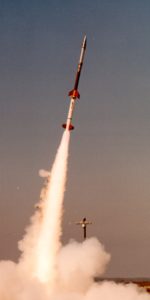
The 250 ft. diameter radio telescope at England’s Jodrell Bank Observatory is expected to draw 10,000 people in June to view the kind of space rock discoveries that have helped keep the historic space facility operational in tight economic times.
Rock music that is.
On June 23 and 24 the observatory will host two major concerts, one headlined by the popular British music group “Elbow” and the other by renowned British artist Paul Weller.
“I am a space nut,” Weller said. “My cat is even named after the woman who discovered pulsars. As you would imagine, playing alongside the local icon of space exploration fills me with cosmic glee,” he said according to the entertainment website CrashMusic.com.
Each concert is expected to draw 5,000 people and include several other celebrities like the international star “Blondie” who appeared at the 2011 Jodrell concerts.
Jodrell Bank’s 210 ft. Mark I “Lovell” radio telescope is a major star of the show. It is named after Sir Bernard Lovell, 98, who is a pioneering figure in space science and founder of the observatory.
In addition to a spectacular backdrop, the giant antenna is maneuvered during the show to point parallel to the ground where it is then used as a giant screen on which is projected colorful space images and videos to match the beat of the music.

The shows “Live at Jodrell Bank” began in 2006 to help fund some of the Observatories’ programs and broaden awareness on space science among the British public. The British government had been considering major funding cuts at the site, but after a public uproar following the shows, the threat of radio astronomy cuts was withdrawn.
“Live from Jodrell Bank are a diverse array of shows spanning across all genres of music with some of the best international and nationally renowned artists,” Ben Robinson, co-founder and director of the concert program said after a major British music award honored Jodrell Bank’s concert programs.
The Jodrell Bank concerts “have always boasted a line up that punches well above its weight, plus has a plethora of entertainment for all ages, without the heavy price tag,” he said.
The main instrument at the observatory is the 250 ft. diameter Mark I Lovell Telescope, which is the third largest steerable radio telescope in the world. There are three other active telescopes located at Jodrell Bank. They are the 125 ft. Mark II, as well as 42 ft and 23 ft. diameter radio telescopes. Jodrell Bank Observatory is also the base of the Multi-Element Radio Linked Interferometer Network (MERLIN), a National Facility run by the University of Manchester on behalf of the British Science and Technology Facilities Council.
The observatory, south of Manchester in northwest England, was established in 1945 by its first director Bernard Lovell who was later knighted by Queen Elizabeth. It has since played an important role in the research of meteors, quasars, pulsars, masers and gravitational lenses, and was heavily involved with the tracking of Soviet and American space probes at the start of the Space Age. The managing director of the observatory is now Professor Simon Garrington.

The name of the site came from a ground rise called Jodrell Bank. The first use of the site for astrophysics was in 1945, when Bernard Lovell wished to use some equipment left over from World War II, including a “gun laying radar” to investigate cosmic rays.
He originally intended to position the equipment at the University of Manchester, England, however electrical interference from nearby trams prevented him from doing so. In December 1945 he moved the equipment to Jodrell Bank 25 miles south of Manchester. Lovell’s main topic of research at the time was transient radio echoes, which he confirmed were from ionized meteor trails.
World class cutting edge radio astronomy took a giant leap at Jodrell Bank in 1957 with the completion of the 250 ft. diameter Mark I Telescope later named after Sir Bernard Lovell, now nearing his 100th birthday.
When built it was the largest steerable dish antenna in the world, and is today the third largest behind only 330 ft. antennas at Green Bank, West Virginia and Effelsberg, Germany. Part of the Mark 1’s control system is made of the gun turret mechanisms from the World War II Royal navy battleships HMS Revenge and HMS Royal Sovereign.
The telescope became operational in mid-1957, just in time for the Soviet’s launch of Sputnik 1, the world’s first artificial satellite. The telescope was the only one in the world able to track Sputnik’s booster rocket by radar.
In the following years, the telescope was used to track a variety of space probes especially key Soviet space missions some tracked in cooperation with the U. S. Defense Dept.
In February 1966, Jodrell Bank tracked the Soviet unmanned moon lander Luna 9 and recorded its facsimile transmission of photographs from the lunar surface. In a Cold War gotcha, Bernard Lovell sent the lunar surface pictures to the British press which published them well before the Soviets themselves made the photos public.
Despite the publicity surrounding the telescope’s tracking of space probes, this only took up a fraction of its observing time. The bulk of its time was used for scientific observations. These included using the Mark 1 as a giant radar dish to measure Earth’s distance to the Moon and to Venus and for diverse radio astronomy observations of distant galaxies and objects. The three radio telescopes at Jodrell Bank continue that work today.

A major achievement of the observatory was the discovery of the first “gravitational lens” a phenomenon now used by astronomers to routinely observe extremely distant objects with the aid of gravity waves given off by closer objects within the same line of sight. The technique can boost the clarity and magnification of more far away targets.
And Jodrell Bank also figured in the final week of the Space Race between the U. S. and the Soviet Union.
In July 1969, the Soviet Union’s Luna 15 was launched a covert mission to land on the moon and return a robotic lunar sample before Apollo 11 made the first manned lunar landing and sample return. Jodrell Bank, however, was tracking it every step of the way.
As the Apollo 11 crew was enroute to the Moon it received a radio message from Mission Control that instead of beating Apollo 11, Luna 15 had actually crashed on the moon as determined by Sir Bernard Lovell using the Mark I (below) to track the Soviet spacecraft to impact.
Missions » Apollo »






